Dear Aspirants, IBPS Clerk 2018 Preliminary Examination is scheduled to be held on 8th, 9th, 15th and 16th of December. Candidates who have a dream to crack the IBPS Clerk 2018 need to speed up the preparation from now.
Our IBPS Guide team is providing a full-length Sectional Tests for English Language, Reasoning Ability and Numerical Ability with precise solutions for assisting you to crack IBPS Clerk Prelims exam.
Take Free Reasoning Ability Sectional Test of 35 Questions as like in the real exam to analyze your preparation level. Our Sectional Test Questions are taken as per the latest exam pattern and so it will be really useful for you to crack the prelims exam lucratively. Students who are weak in Reasoning Ability should utilize this chance constructively to accomplish a successful profession in Banking Field.
[WpProQuiz 4169 ]
Click Here for IBPS Clerk Prelims 2018 High-Quality Mocks
Direction (1-5): Study the following information carefully and answer the questions given below:
A, B, C, D, E, F, G, and H are sitting in a square table. Four of them are sitting in the middle and facing inside and four of them are sitting in a corner and facing outside. Person name starts with consecutive alphabet does not sit adjacent to each other.
B sits second to the left of E. Only two persons are sitting between H and B. A and F are facing same direction. G sits second to the right of C. Only two persons are sitting between A and D and A faces outside.
1) What is the position of F with respect to A?
a) Immediate right
b) Immediate left
c) Second to the right
d) Second to the left
e) None of these
2) How many persons sit between D and C ?
a) None
b) One
c) Two
d) Three
e) More than three
3) Who among the following persons are sitting the immediate neighbours of C?
a) A, E
b) E, B
c) A, H
d) F, B
e) None of these
4) Which of the following statements is / are true?
i) B sits an immediate left of D
ii) Only two persons sit between D and H
iii) F is an immediate neighbour of H
a) Only I
b) Only II
c) Only I and II
d) Only I and III
e) All I, II and III
5) In a certain way A is related to G, E is related to D, in the same way F is related to who among the following person?
a) A
b) B
c) C
d) D
e) E
Direction (6-10): Study the following information carefully and answer the questions given below:
Nine Boxes G, H, I, J, K, L, M, N, and O are placed one over other in a stack but not necessarily in the same order. Only two boxes are placed between Box K and Box H. Box L and Box K are not placed at adjacent position. Box N does not placed at the top. Only three boxes are placed between Box L and Box M. Box G is placed just above the box I. There are three boxes are placed between Box O and Box N. Box K is placed third position from the top. Only one box is placed between Box J and Box O. Box L and Box O are not placed at adjacent position. Box J is placed just below Box H.
6) Which of the following box is placed at the top?
a) J
b) H
c) I
d) N
e) None of these
7) How many boxes is /are placed between M and K?
a) None
b) One
c) Two
d) Three
e) More than three
8) Which of the following box(es) is /are placed adjacent to Box N?
a) L, J
b) G, I
c) L
d) K
e) None of these
9) Which of the following statements is / are true?
i) N is placed at the bottom most position
ii) Only two boxes are placed between J and I.
iii) Box O is placed just above of Box M
a) Only I
b) only II
c) only I and II
d) Only I and III
e) All I, II and III
10)In a certain way, Box L related to Box H, Box O related to Box K in the same way Box M is related to which of the following boxes?
a) H
b) I
c) L
d) N
e) None of these
Direction (11-14): In these questions, relationships between different elements are shown in the statements. These statements are followed by two conclusions. Find the conclusion which is definitely true.
A) Both conclusion I and conclusion II follows
B) Only Conclusion I follow
C) Either Conclusion I or Conclusion II follows
D) Neither Conclusion I nor Conclusion II follows
E) Only Conclusion II follow
11) Statements
A < B ≥ C, D ≤ C ≥ E, F < G = E
- F < B
- E > C
12) Statements
I > J ≤ K, J = H > L, M ≥ N < L
Conclusions
- K < N
- N < J
13) Statements
M ≥ N = O, P < N = Q, R = S ≤ Q
Conclusions
- M > R
- R = M
14) Statements
T < U = V, W < U > X, Y ≥ Z ≤ X
Conclusions
- T < Z
- V > Y
Direction (15-17): Study the following information carefully and answer the questions given below:
In a family consist of eight members P, Q, R, S, T, U, V, and W belongs to three different generations. There are three married couples. P is the maternal uncle of T. V is the sister in law of W. Q is the son in law of R. W is the mother of S and daughter in law of U. S is the nephew of V. U is the grandfather of T.
15) How is R related to S?
a) Mother
b) Grandmother
c) Father
d) Father in law
e) None of these
16) How is T related to P?
a) Niece
b) Nephew
c) Son
d) Can’t be determined
e) None of these
17) How is Q related to P?
a) Sister
b) Sister in law
c) Brother in law
d) Brother
e) None of these
Directions (18-20): Study the following information carefully and answer the questions given below.
![]()
18) How many consonants are there in the arrangement which is immediately followed by vowel and immediately preceded by number?
a) None
b) One
c) Two
d) Three
e) None of these
19) If all the symbols from the above sequence are dropped, which of the following element is 12th to the left of the element which is 10th from the right end?
a) B
b) 9
c) C
d) 8
e).None of these
20) How many vowels are there immediately followed by number and immediately preceded by consonant?
a) None
b) One
c) Two
d) Three
e) None of these
Direction (21-25): Study the following information carefully and answer the questions given below:
Certain number of persons are sitting in a straight line and facing north. Only four persons sit between W and U. Q sits fourth to the left of R. Number of persons sit between V and P is one less than the number of persons sit between V and T. Q is an immediate neighbour of T. Only one person sits between W and P. Either W or U sits at the extreme right end. S is an immediate neighbour of R and only one person sits between S and T. There are six persons sit between P and S. Only five persons sit to the left of S. Number of persons are sitting in the row is less than twenty members but not fifteen.
21) How many members are sitting in the row?
a) 14
b) 17
c) 16
d) 19
e) None of these
22) What is the position of Q sits from the left end?
a) Extreme left
b) First
c) Second
d) Third
e) None of the above
23) How many persons sit between S and W?
a) None
b) one
c) Two
d) Three
e) More than three
24) Which of the following statements is / are true?
i) P sits fourth from the right end
ii) More than three persons sit between W and R
iii) Q sits an immediate right of T
a) only I
b) only II
c) only I and II
d) Only I and III
e) All I, II and III
25) Who among the following person sits in the exactly middle of the R and the W?
a) P
b) S
c) Q
d) V
e) None of these
Directions (26-30): Study the following information carefully and answer the questions given below.
Six persons U, V, W, X, Y, and Z have attended the seminar on different months viz., January, February, March, April, May, and June of the same year. They like different subjects i.e. Biology, Chemistry, Maths, Physics, English, and Computer but not necessarily in the same order.
Z likes Chemistry and attends the seminar immediately after the one who likes Biology. X attends the seminar neither February nor April. The one who likes maths attends the seminar in the month of March. W likes physics and attends the seminar in the month which has less than 31 days but not on June. Y attends the seminar neither January nor March. Only one person attends the seminar between W and X. Only one person attends the seminar between the one who likes Maths and the one who likes Biology.
26) Who among the following person attends the seminar in the month of March?
a) V
b) U
c) W
d) Either a or b
e) None of these
27) Y attended the seminar on which one of the following months?
a) January
b) February
c) March
d) April
e) None of the above
28) How many persons have attended the seminar between Z and the one who likes physics?
a) None
b) 1
c) 2
d) 3
e) None of the above
29) Which of the following statements is / are true?
i) Y likes Computer.
ii) W attends the seminar in the month of April.
iii) U attends the seminar just after the one who likes chemistry.
a) Only I
b) Only II
c) Only I and II
d) Only I and III
e) All I, II and III
30) Which of the following subject Y likes?
a) Biology
b) English
c) Computer
d) Either b or c
e) None of these
Directions (31-33): Study the following information carefully and answer the questions given below.
“Businesses are difficult nowadays” is called as “uv kl ij xy”
“Nowadays competitors are active” is called as “mn yz ij kl”
“Offers boost businesses nowadays” is called as “pq xy kl lm”
“Finding active competitors are difficult” is called as “tu yz uv ij mn”
“Competitors give good offers” is called as “lm mn pi sp”
31) What is the code for “Boost” in this code language?
a) kl
b) lm
c) pq
d) xy
e) None of these
32) What is the code for “Good” in this code language?
a) sp
b) pi
c) lm
d) Either a or b
e) None of these
33) Which of the following words come for the code “yz” in this code language?
a) Finding
b) Active
c) Competitors
d) Offers
e) None of these
34) The position of how many alphabets will remain unchanged if each of the alphabets in the word “ENCROACHMENT” is arranged in alphabetical order from right to left?
a) None
b) One
c) Two
d) Three
e) None of these
35) If “1” is subtracted from each odd digit and “1” is added to each even digit in the number 12345679, then how many digits appear twice in the new number thus formed?
a) None
b) One
c) Two
d) Three
e) None of these
Answers
Direction :(1-5)

- B sits second to the left of E.

- Only two persons are sitting between H and B.
- G sits second to the right of C (Person name starts with consecutive alphabet does not sit adjacent to each other).
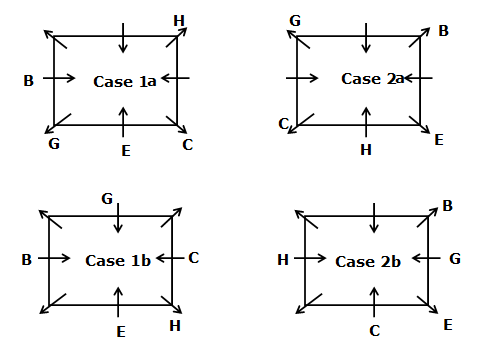
- Only two persons are sitting between A and D and A faces outside.
- A and F are facing the same direction.

- In case 1a, 1b and case 2a, only two persons are sitting between A and D, and A faces outside. These conditions are not satisfied by these above mentioned cases, so these cases are eliminated.
- And Case 2b will be the final arrangement.
1) Answer: c)
2) Answer: d)
3) Answer: a)
4) Answer: d)
5) Answer: e)
Direction :(6-10)

Box K is placed third position from the top. Only two boxes are placed between Box K and Box H. Only one box is placed between Box J and Box O. Box J is placed just below Box H.
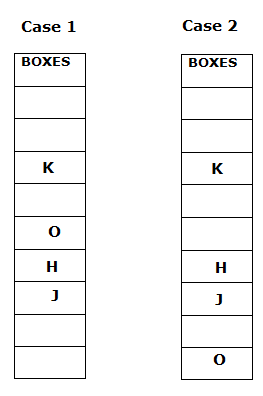
Box G is placed just above the box I. Box N does not placed at the top. There are three boxes are placed between Box O and Box N.
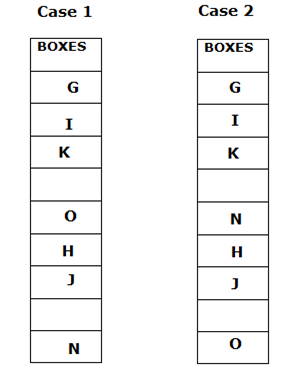
Only three boxes are placed between Box L and Box M. Box L and Box K are not placed at adjacent position. Box L and Box O are not placed at adjacent position.
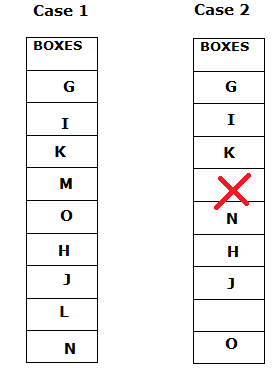
In case 2, Box L and Box K are not placed at adjacent position. Box L and Box O are not placed at adjacent position. This condition is not satisfied So this case is eliminated and case 1 will be the final arrangement.
6) Answer: e)
7) Answer: a)
8) Answer: c)
9) Answer: a)
10) Answer: b)
Direction :(11-14)
11) Answer: b)
- F < B (F < G = E ≤ C ≤ B) -> True
- E > A (E ≤ C ≤ B > A) -> False
12) Answer: e)
- K < N (K ≥ J = H > L > N) -> False
- J > N (J = H > L > N) -> True
13) Answer: c)
- M > R (M ≥ N = Q ≥ S = R) -> False
- R = M (M ≥ N = Q ≥ S = R) -> False
(Either I or II can be true)
14) Answer: d)
- T < Z (T < U > X ≥ Z ≤ Y) -> False
- V > Y (V = U X ≥ Z ≤ Y) -> False
Direction :(15-17)
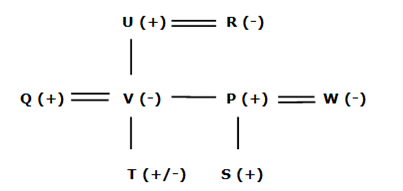
15) Answer: b)
16) Answer: d)
17) Answer: c)
Direction :(18 -20)
18) Answer: b)
A B C 9 8 D E % ? F G H I 8 7 3 V J @ 6 2 P Q = W X Y Z L
19) Answer: c)
A B C 9 8 D E F G H I 8 7 3 V J 6 2 P Q W X Y Z L
20) Answer: b)
A B C 9 8 D E % ? F G H I 8 7 3 V J @ 6 2 P Q = W X Y Z L
Direction: (21-25)

Only four persons sit between W and U. Only one person sits between W and P. Either W or U sits at the extreme right end.
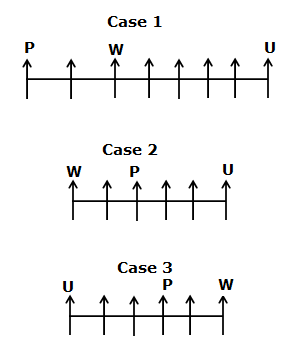
Only six persons sit between P and S. Only five persons sit to the left of S. Number of persons are sitting in the row is less than twenty members but not fifteen.
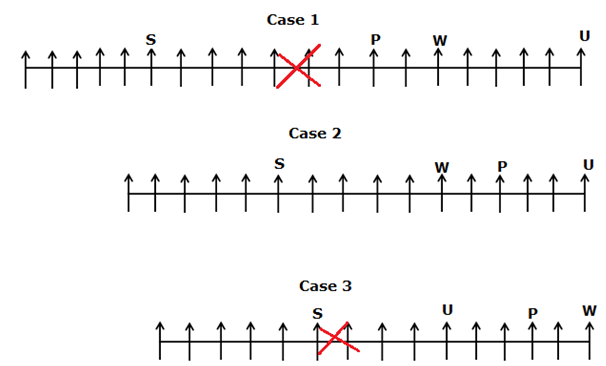
In case 1, Number of persons are sitting in the row is less than twenty members, this condition is not satisfied, so this case is eliminated.
In case 3, Number of persons in the row are not fifteen so this case is eliminated.
Q sits fourth to the left of R. Number of persons sit between V and P is one less than the number of persons sit between V and T. Q is an immediate neighbour of T. S is an immediate neighbour of R and only one person sits between S and T.
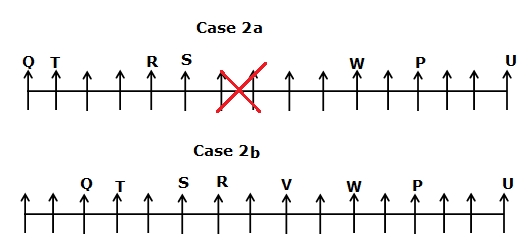
In case 2 a, Only one person sits between S and T, this condition is not satisfied, so this case 2 a is eliminated.
21) Answer: c)
22) Answer: d)
23) Answer: e)
24) Answer: a)
25) Answer: d)
Direction :(26-30)
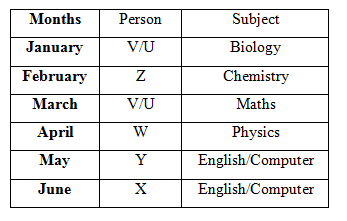
The one who likes Maths attends the seminar in the month of March. Only one person attends the seminar between the one who likes Maths and the one who likes Biology. Z likes Chemistry and attends the seminar just after the one who likes Biology. W likes physics and attends the seminar in the month which has less than 31 days but not on June.
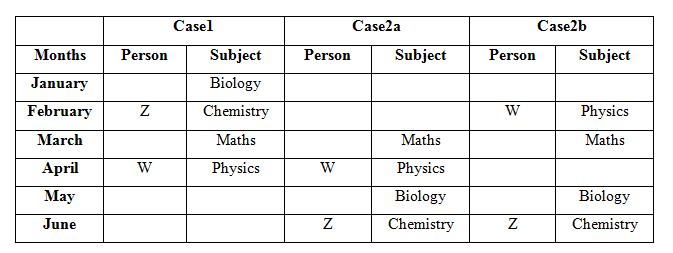
X attends the seminar neither February nor April. Only one person attends the seminar between W and X.
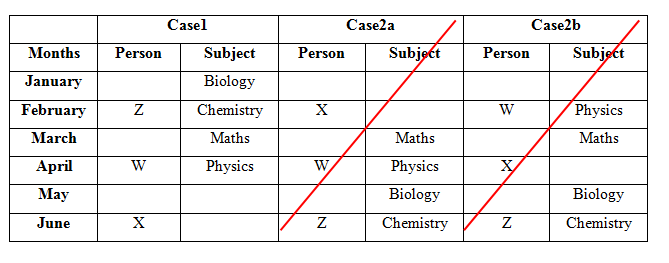
Incase 2a and 2b, X attends the seminar neither February nor April. This condition is not satisfied so this case is eliminated.
Y attends the seminar neither January nor March. So the final arrangement becomes

26) Answer: d)
27) Answer: e)
28) Answer: b)
29) Answer: b)
30) Answer: d)
Direction :(31-33)
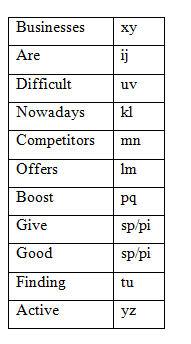
31) Answer: c)
32) Answer: d)
33) Answer: b)
34) Answer: a)

35) Answer: a)

Click Here for IBPS Clerk Prelims 2018 High-Quality Mocks





